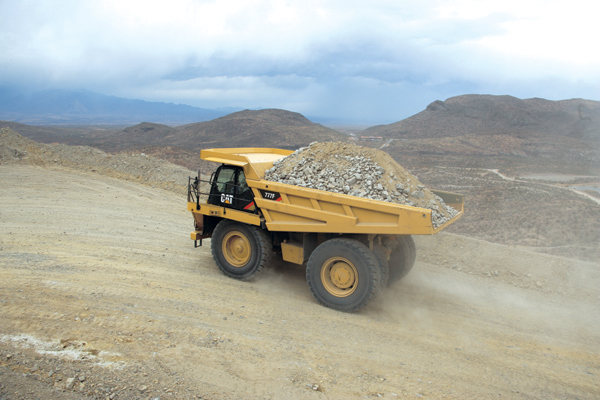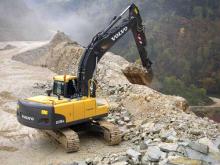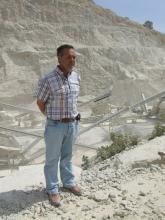
When it comes to hauling and loading options for quarries,
Quarries and the aggregate production process represent an important market for equipment manufacturers, not only because of the volume of machines sold but also the physical size of them. Caterpillar is no different and has a whole team dedicated to working with the quarrying sector to ensure new machine development matches customer needs.
The man charged with leading Cat's quarrying and aggregates support team in Europe, Africa and the Middle East is Vincent Migeotte. He believes that having a real understanding of the industry is essential, not just for Cat's sales figures but also for those of the quarry owners.
"Cat is one of the largest, if not the largest, supplier of hauling and loading equipment for the quarrying and aggregates market," said Migeotte. "Working closely with our customers in this important segment means that we can react quickly to their needs. And through this in-depth knowledge of the sector, we can see opportunities to bring innovation and transfer new technology from other areas of our business into the quarrying market.
"Quarry customers often tend to come to Cat to find a solution for their production needs rather than to buy an individual machine. The solution for one site may mean a complete new fleet of machines but for others it could involve optimising the use of the equipment they already have by changing the layout.
"This means we need to work closely with them to understand their individual businesses and through this we often build a good long term working relationship. For Cat this allows us to see at first hand how the demands of the industry are changing and understand how it could evolve in the future.
"On a personal level, having this in-depth involvement often means you get involved when the quarry is in the final stages of planning permission to help supply the equipment. From there we often help owners manage the operating costs and ensure parts are available at the right time, and sometimes also help when it comes to rebuilding machines too. Staying involved throughout the life of the quarry is very satisfying and rewarding."
Quarry qualified
Migeotte took on his lead role in November last year but he has been involved in the quarrying industry almost throughout his career at Cat. Belgian-born Migeotte is well suited to working closely with the quarrying sector - his interest in aggregate extraction started when he was a young boy.
"I grew up in the Tournais region of Belgium where there are lots of quarries and I used to go and watch the big machines at work through the fence," he said. "Like most boys I enjoyed playing with models of the machines in the sand box and dreamed of working for a big manufacturer one day." Migeotte went on to study mechanical engineering at university before he joined Cat, where his career development has given him a good understanding of the quarrying sector.
"I joined Cat in 1995 and worked in the Belgian assembly plant as an assembly line quality analyst for the mid-sized loader production line. After that I undertook the 18 month-long Cat training programme, which gives employees a good grounding in not just the company's approach to work but also the range of regional and industrial markets it serves," explained Migeotte.
He went on to work with Cat's dealers in Germany, Austria and Switzerland, where he looked after the quarrying customers, before moving to a similar role in Canada. "Working with our dealer networks gave me a broad knowledge base in our machine range, while working with the quarrying customers helped me to understand their needs," said Migeotte.
After over six years working closely with Cat's dealers and customers, Migeotte moved from Canada to Geneva to take on his current post.
Site visits
Having built up his quarrying knowledge through first hand experience, he encourages his team to get out into the quarries whenever they can. "It is essential that we all understand the issues facing today's quarries and know what their concerns are," said Migeotte. "They usually spend 30 to 50% of their time out on site. I have less time at the quarry face these days, so I do rely on my team to know what is going on but I still try to get out and meet customers for a few days each month." Information gathered by Migeotte's team is fed into Cat's research and development programme through regular meetings with the engineering team.
The results of the information gathered can be seen in Cat's current production range. "It was customer demand for better safety that drove development of the new F series trucks," said Migeotte. "Access to the cab has been improved and we also moved the cab closer to the centreline of the machine to provide better all-round visibility." Customer demands for reduced operational costs have been strongest from the quarrying sector, according to Migeotte. "The larger machines used in quarries do often have higher fuel consumption rates than machines found in the construction sector, so the rising price of fuel has been a major concern," he said. "Cat has achieved some tremendous improvements in fuel efficiency in the last few years." To show Cat's activity on this front, Migeotte pointed to the launch this autumn of the new fuel management system for Cat's 988H loaders (ABE, September/October 2007). The system can cut fuel bills by more than 15% and can also be retro-fitted, adding to the benefit for customers.
"Cost is likely to continue to be a major concern for quarry operators," said Migeotte. "Fuel prices will probably continue to rise, which combined with the level of competition in the European market means that operators need to make savings wherever they can. Our close links with the sector positions us well to help deliver the tools to allow operators to achieve this." According to Migeotte, other issues that are still causing concern for quarry operators in Europe are the recruitment of skilled machine operators and the scarcity of off road tyres for larger machines.
"It is not unusual for quarries to have one or two trucks standing still just because the quarry owner cannot source new tyres for their machines," he said. "Cat is also experiencing difficulties and has had to look for alternative suppliers to ensure that tyres do not impact on our lead times for new machines.
"Many quarries are also finding it difficult to recruit and retain operators and it is this problem that has driven the recent evolution in cab design to make machines more comfortable, safer and less tiring to drive. Demand for more improvements is likely as quarry operators increasingly involve machine drivers in the buying process in a bid to retain them."
Las Vegas launches
Migeotte believes that the growth seen in the equipment market for quarry sized machines is likely to continue over the next few years. "We are seeing more and more customers add to their fleets, rather than just replacing machines," he said.
Cat's quarry customers will also have more options open to them from next year. According to Migeotte, Cat is likely to be unveiling new machines for the quarrying sector at this year's













